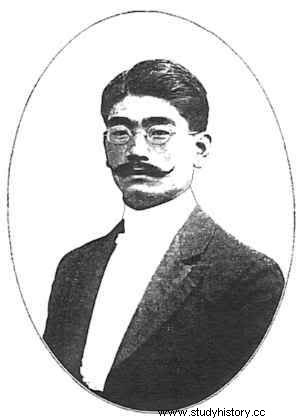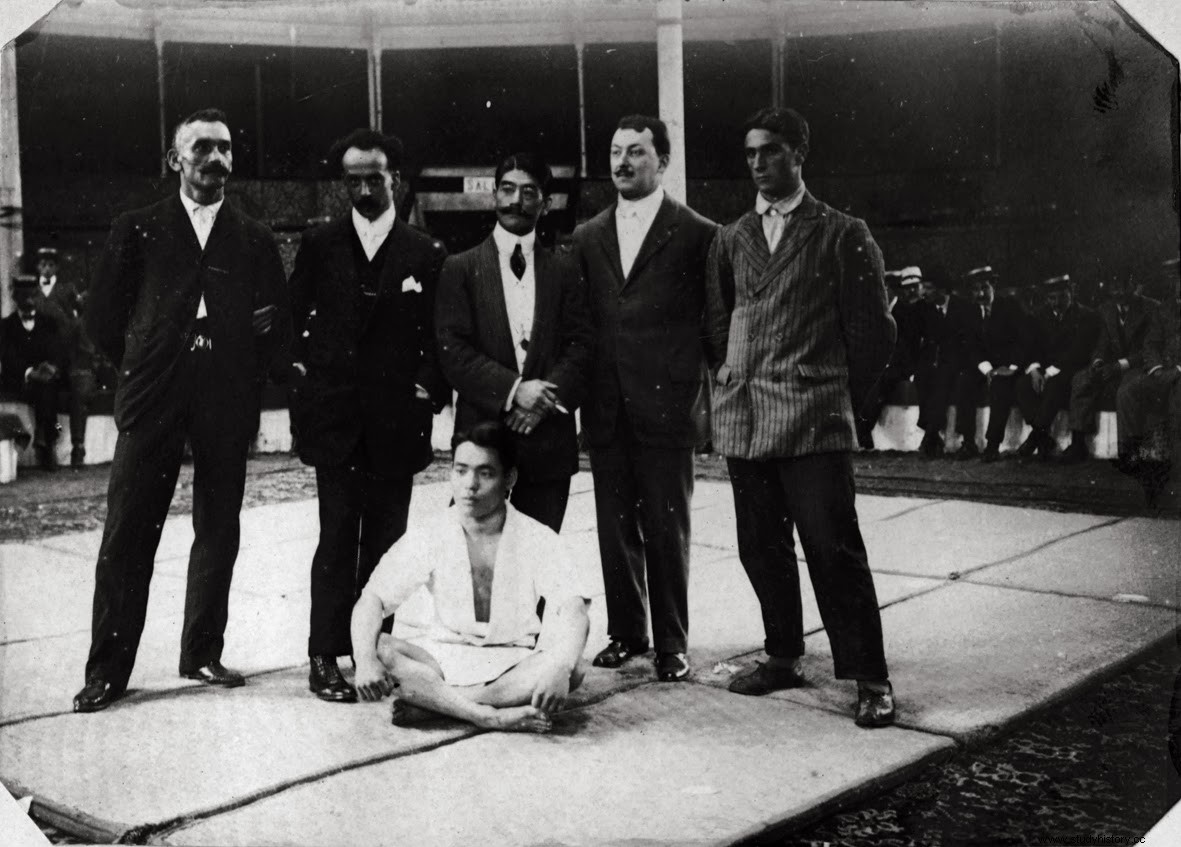One night in 1909, the Zaragoza public attended with their hearts in their fists what, without a doubt, was the fight of the century or, at least, what was taking away from the newly released 20th century. On one side of the ring, with 58 kg. weight and 1.65 m. tall, Sadakazu Uenishi , alias «Raku «, Japanese jiu-jitsu master undefeated since he set foot on European soil nine years ago. In the other the challenger, with more than 100 kg. and a stature several heads higher than that of his adversary, a colossus baturro known as Abadía el del Arrabal by his countrymen. A match in style. Little did Raku, a fine stylist expert in the lethal arts of jiu-jitsu, imagine that this strong Aragonese was going to be the last of his shoe. That would be, according to his words, the most difficult fight of his life.

Raku
But, what was a Japanese painting giving cakes with one hand in a circus tent in front of hundreds of people? In fact, in Europe at the beginning of the 20th century, exhibition fights by Japanese martial artists were common. Japan was very fashionable in the chic environments of the Belle Époque. Everything that came from there aroused interest and admiration for its deep charge of exoticism. It is what came to be called japonism , a cultural movement that idealized and imitated oriental motifs. His influence can be palpably seen, for example, in the painting of the first impressionists, such as Degas or Renoir.
But the impact of this japonism that swept Europe at the time was not limited to the fine arts. It also reached sport, which at that time was beginning to take on the dimension of a mass spectacle that it has today. Thus, in the shadow of the newborn boxing, other combat sports also proliferated, and soon martial arts experts began to flock from the other side of the world ready to demonstrate to a receptive European public the virtues of their traditional fighting methods.
In the great capitals of the Old World, judo, jiu-jitsu, karate schools arose like mushrooms... And the best way they had to promote themselves and attract students was through exhibition combats. The popularity of these shows was such that it soon became common to see teachers from this or that school touring various countries to teach the world their prodigious techniques.
One of these pioneers was the Sadakazu Uenishi of our history. Born into a family of masters in martial arts of ancient ancestry, he had practiced several of them in his childhood, until specializing in jiu-jitsu. In 1900, in his early 20s, he settled in London with his partner Yukio Tani to work as a master instructor at the Bartitsu Club of the British capital. The bartitsu It can be considered the grandfather of current MMA (mixed martial arts systems), as it was a curious and chivalrous method of self-defense that mixed Eastern techniques with traditional European fighting styles. Sherlock Holmes readers will be familiar with the name, as the Baker Street detective was an accomplished bartitsu expert. .
Shortly after arriving in London, Uenishi decides to adopt the stage name of Raku , much easier to remember by his new students, and by that name he would be known from then on. The truth is that Raku knew how to adapt wonderfully to life in Europe. As we can read in the chronicles of the time, he was a true gentleman, a lover of good food and good dress, with people skills and a very busy social life. Over time, Raku ended up leaving behind the bartitsu and focusing on the teaching of traditional jiu-jitsu. His fame only grew every day. He opened new schools, began to demonstrate in neighboring countries, and even wrote a treatise on jiu-jitsu, which at the time was the first book on the subject published in the West.
His tours caused a real furor. The routine of the show was simple, but effective. He used to start with a self-defense demonstration, to make the public aware of how useful jiu-jitsu could be. An assistant dressed as a robber and Raku he would dispatch him with a series of locks and throws, while he gave practical advice on how to defend yourself in tight situations. The high point came when Raku he stuffed himself into his dogi (wrestling suit) and, after doing warm-up exercises breaking some brick or the like, he challenged some brave member of the public to get into the ring to fight with him.
At first, he looks like Raku , a skinny guy and dressed in some kind of bizarre pajamas, did not impress too much. But when he began to distribute tow, the smiles and jokes turned into loud applause. The Japanese master knew how to get the respectable into his pocket with a couple of moves. Basically, those exhibition matches were not far from being a circus show and, in fact, he often had to share the stage with conjurers and variety numbers. But the public loved it, and Raku didn't dislike that show business either.

Raku (in the center) and his assistant (seated) before an exhibition match in Bilbao
One of his tours of Europe took him to Spanish lands, which brings us back to the battle of the century, the evening in Zaragoza with which we began these lines. The Raku fight against local strongman Abadía it was such a notorious event that the match was profusely echoed in the press of the time. The reward for defeating raku was 500 pesetas, a good pinch for Spain at the time . Raku himself He remembered it, months later, in an interview for the newspaper El Noroeste, in which he came to say that never before in his life had he been so close to hitting her in the ring. The following account of the fight is based on his words.
Abadía was a villager, but tremendously corpulent. Raku he describes it as a kind of shirted bear, with hands that looked like tiger claws. As soon as the fight began, Abadía pounced on him and grabbed him with the intention of throwing him into the air, but the Japanese responded to the prey in the same way and also locked his opponent. They both rolled on the canvas and Raku He was left under the immense body of Abadía. As if the one hundred and odd kilos of weight of the colossal baturro were not enough, Raku had to dodge as best he could his slaps, real shells that went straight into his face. Ground fighting is the specialty of jiu-jitsu, but Abadia's hulking bulk, a true force of nature, was putting Raku in serious trouble. Not even with the full arsenal of jiu-jitsu tricks could he get the stubborn Abadía off his back. When the respectable already considered his countryman the winner, Raku he resorted to a technique never seen before:he pressed his rival's neck with two fingers until the latter, half asphyxiated, loosened his grip and fell unconscious. It seemed like magic. Raku , whose body mass was practically half that of his opponent, won by fulminant KO.

Jiu-jitsu demonstrations were all the rage in Belle Époque Europe
Fans of modern MMA tournaments will have guessed that the Japanese had used a shime waza , that is, a choke key. Pressing the trachea or neck veins for long enough prevents oxygen and blood from flowing to the brain and causes the opponent to pass out. But, unfortunately, the public of the time did not fully understand the subtleties of oriental martial techniques. To the onlookers, it was simply impossible that Abadía had suddenly passed out like that, when he had practically won the fight. There had been a tongo like a cathedral. The thing ended like the rosary of dawn, with a mob of angry spectators wanting nothing less than to lynch the winner and poor Raku him having to leave the premises escorted by the police, like a Third Regional referee after calling a penalty against the local team.
After that Raku he returned to London and, a few years later, ended up returning to his native Japan. There the track is definitely lost, although everything seems to indicate that he died, due to natural causes, shortly before the start of the Second World War. But, although we assume that he spent his last days away from the world and the stage, he would hardly forget the good old Raku his passage through Spain. That night in Zaragoza in which a giant maño with tiger hands was about to bite the dust.
Collaboration of R. Ibarzabal , from Samurai Stories
Sources:A jujutsu master in Asturias. Raku in the periodic press of his time (1909-1910), Ramón Vega, Echoes of Asia Magazine
